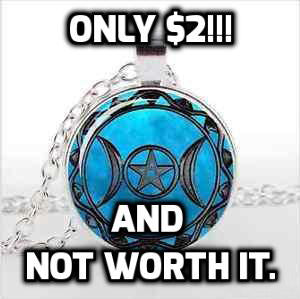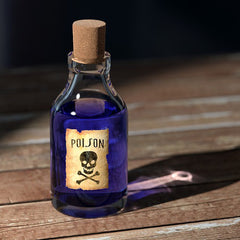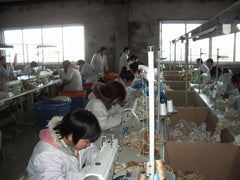
If you shop for Pagan and spiritual jewelry online, your browser is most likely bursting with ads for cheap imported baubles. But there are plenty of good reasons why you shouldn’t bite. Supporting these merchants hurts Pagan artisans (and possibly yourself).
Based overseas, companies like “Wicca Movement,” “Enchantory” and “Wicca Store USA” use aggressive marketing tactics to reach customers in the United States. They offer pendants, bracelets, and other trinkets at tempting prices—sometimes only a dollar or two including shipping. Even formerly craft-friendly sites like Etsy are now flooded with galaxies of cheaply-made pentacles and crescent moons.
Some of this market glut is due to American resellers who import these items wholesale and pass them along to customers at steep margins. It’s understandable why they would do this. I’ve done it, too. If you can buy a necklace at a cost of 35 cents and sell it for as little as $3, that’s still almost 800% markup—far better than you’re likely to obtain from any domestic wholesaler.
Earlier in 2016, we made the decision to stop carrying jewelry imported from Asia in our shop. With the exception of some gemstone items which are mined and finished in China, we’ve phased out these purchases completely. All of our pewter and bronze jewelry is now manufactured in the United States, Canada or the UK.
Since I’ve made this change, I feel a lot better about the jewelry I send home with my customers. I often find myself telling others why cheap Pagan jewelry is not the great deal it seems to be. Here’s a handful of reasons why you should consider upgrading to US-made jewelry:
It’s safer.

In traditional metallurgy, “pewter” refers to an alloy of mainly tin, with copper, antimony, and/or bismuth added. In online seller language, “pewter” can refer to any mix of metals that is vaguely silver-colored. Usually, the main metal is zinc—a (mostly) harmless substance. But lead contamination is a very common issue with imported jewelry. Even if the seller claims the product is lead-free, you never really know what’s in that “mystery metal.” That's a big concern for something you plan to wear against your skin or near your face every day.
How widespread is the problem? In 2012, a watchdog group tested costume jewelry from the shelves at popular chains like Target, Claire’s, and Hot Topic. Over a third of their samples contained worrisome levels of the following: Lead, cadmium, chromium, nickel, brominated flame retardants, chlorine, mercury and arsenic. In the international online marketplace (where materials safety is completely unregulated) the percentage is probably even higher.
Toxic metals can cause cancer, brain damage, and reproductive harm with continued exposure. Some of these substances can be absorbed through the skin. Sometimes microscopic particles flake off and are breathed in or ingested. Jewelry with impurities is also far more likely to cause skin rashes and allergic reactions in sensitive people.
The US government doesn't regulate the metal content of jewelry, except in items intended for children. But self-regulation and state legislation have pushed United States foundries to be far more responsible than Chinese factories. Many participate in voluntary testing and labeling to keep harmful ingredients out of their products.
It looks better.

Lots of Pagan jewelry makers take pride in their work and strive for consistency and quality. Putting out a new cast metal design is time-consuming. So they want to make a classic design that will sell well for years to come and build their reputation as an artist.
Not so for the mass-producers, who will never meet most of their customers and are always trying to catch up with the latest trend. Basically, you get what you pay for. If you like hollow pendants, misspelled talismans, and headless fairies—well, you know where to go.
Then there’s the originality factor. Small companies have smaller marketing budgets. Buy from them, and you won’t be sporting the same pendant that’s been spamming everyone’s Facebook feed for weeks on end.
It doesn’t exploit workers.

No, I’m not going to turn this article into a lecture about factory conditions. For one thing, I don’t have a lot of info about how this cheap Pagan jewelry is made. But c’mon now: It doesn’t take a genius to figure out if someone can make a necklace, advertise it, and ship it around the world for less than $1, some workers somewhere are not making very much money. They are also probably being exposed to the toxic materials mentioned earlier.
When you shop domestically, you don’t have to worry as much about workers’ safety. Everyone in the supply chain is making at least the minimum wage (unless they're self-employed of course!) and working in reasonably safe conditions. Especially for your sacred jewelry, why would you settle for anything less?
It’s created with intention.

Have you ever noticed that the same Chinese factories who make Wiccan jewelry also make Christian crosses and Satanic pentagrams (and saints, angels, skulls, fairies, and whatever)? And the Pagan content on their pages seems mostly copied from Wikipedia? That’s because they couldn’t care less. Wicca is, to many of them, just another lucrative Western trend.
Call me uptight, but it bothers me to see sacred symbols cheapened and commercialized by people who seem to have no reverence for them at all. I imagine many Pagans feel the same way. But it doesn't apparently bother the tens of thousands of people who "like," share, and (presumably) purchase this garbage.
Now, I’m not saying that every foreign metalsmith is a sly opportunist, or that every Pagan craftsperson is a wizard or sage. But there are many, many fine artists making beautiful artworks inspired by their spiritual path. (Paul Borda of Dryad Design comes to mind, as does Micki Baumann of Deva Designs.) When they choose to make copies available, they’re passing a gift on to those people who can appreciate the difference.
It’s fair to artists.

Large companies like Apple and Disney are always in the headlines battling fakes and knock-offs of their products overseas. But it’s not just the big guys that are hurt by copycats. Chinese factories copy popular jewelry designs that were created by artists here, robbing them of their ability to make money from their ideas. More than once I’ve purchased pendants for my shop from a legitimate distributor, only to find that there’s a cheap counterfeit version already in circulation. What happens then? I can’t stock that item anymore, because it’s very difficult to sell online at a decent price.
When you buy the genuine article, your purchase helps pay the artist who created it. When you buy the copy, you’re supporting people who steal without consequences.
You’ll get your stuff sooner.

Economy shipping from China can take three weeks or longer. Foreign sellers tend to downplay this fact by offering free shipping and being cagey about where in the world their warehouse is located. (Many won’t answer this question even if asked directly.)
Their Facebook comments and feedback tell the real story: “I’ve been waiting a month for my item and now they’re not returning my emails!!!!” Yup. Budget sea freight (often untracked) is the shipment method for most small international parcels.
Online payment protection means that most of these people will get their item or a refund eventually. But that’s no consolation when you’re staring forlornly at the mailbox. If you’re excited to wear your new jewelry, you’re better off purchasing it stateside.
Like this article? Read more in the archive.
